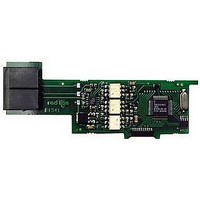PAXCDC40 Red Lion Controls, PAXCDC40 Datasheet - Page 27

PAXCDC40
Manufacturer Part Number
PAXCDC40
Description
Modbus Communications Network Interface Card
Manufacturer
Red Lion Controls
Specifications of PAXCDC40
Accessory Type
Modbus Communications Network Interface Card
Brand/series
PAX Series
Card Type
Extended Modbus Communications Card
Data Rate
7⁄8 Bits
Standards
cULus Listed, CSA Certified and CE Marked
Voltage, Working
50 V
Pax Label Kit
189 Different Engineering Units, Labels Inserted Inside the Unit
For Use With
Red Lion PAX Digital Input Panel Meters
Lead Free Status / RoHS Status
Lead free / RoHS Compliant
COMMAND RESPONSE TIME
operation). During RS232 transmissions, the meter ignores commands while
transmitting data, but instead uses RXD as a busy signal. When sending
commands and data to the meter, a delay must be imposed before sending
another command. This allows enough time for the meter to process the
command and prepare for the next command.
string to the com port, thus initiating a transmission. During t
characters are under transmission and at the end of this period, the command
terminating character (*, $ or slave only <CR>) is received by the meter. The
time duration of t
the channel.
command and when complete, performs the command function. This time
interval t
expected, the meter is ready to accept another command.
of the command terminating character. The ‘*’ or ‘<CR>’ terminating character
results in a response time window of 50 msec. minimum and 100 msec.
maximum. This allows sufficient time for the release of the sending driver on
the RS485 bus. Terminating the command line with ‘$’ results in a response
time window (t
response time of this terminating character requires that sending drivers release
within 2 msec. after the terminating character is received.
character of the reply. As with t
number of characters and baud rate of the channel. At the end of t
ready to receive the next command.
times t
COMMUNICATION FORMAT
In serial communications, the voltage is switched between a high and low level
at a predetermined rate (baud rate) using ASCII encoding. The receiving device
reads the voltage levels at the same intervals and then translates the switched
levels back to a character.
lists the voltage levels for each standard.
characters (0 to ). Each ASCII character is “framed” with a beginning start bit,
an optional parity bit and one or more ending stop bits. The data format and
baud rate must match that of other equipment in order for communication to
take place. The figures list the data formats employed by the meter.
Start bit and Data bits
receiving device to prepare for reception of data. One bit period later, the least
significant bit of the ASCII encoded character is transmitted, followed by the
remaining data bits. The receiving device then reads each bit position as they are
transmitted.
The meter can only receive data or transmit data at any one time (half-duplex
At the start of the time interval t
At the start of time interval t
If the meter is to reply with data, the time interval t
At the beginning of time interval t
Data is transferred from the meter through a serial communication channel.
The voltage level conventions depend on the interface standard. The table
Data is transmitted one byte at a time with a variable idle period between
Data transmission always begins with the start bit. The start bit signals the
The maximum serial throughput of the meter is limited to the sum of the
* Voltage levels at the Receiver
LOGIC
1
, t
1
0
2
2
varies (See Timing Diagrams). If no response from the meter is
and t
2
3
INTERFACE STATE
) of 2 msec. minimum and 50 msec. maximum. The faster
.
1
space (active)
t
3
is dependent on the number of characters and baud rate of
mark (idle)
= (10 times the # of characters) / baud rate
t
1
= (10 times the # of characters) / baud rate
1
, the time duration of t
2
1
, the meter starts the interpretation of the
, the computer program prints or writes the
TXD,RXD; +3 to +15 V
TXD,RXD; -3 to -15 V
3
, the meter responds with the first
RS232*
2
is controlled by the use
3
is dependent on the
a-b > +200 mV
a-b < -200 mV
1
, the command
3
, the meter is
RS485*
27
Parity bit
a zero or a one, so that the total number of ones contained in the transmission
(including the parity bit) is either even or odd. This bit is used by the receiver
to detect errors that may occur to an odd number of bits in the transmission.
However, a single parity bit cannot detect errors that may occur to an even
number of bits. Given this limitation, the parity bit is often ignored by the
receiving device. The PAX meter ignores the parity bit of incoming data and
sets the parity bit to odd, even or none (mark parity) for outgoing data.
Stop bit
period pause to allow the receiver to prepare to re-synchronize to the start of a
new transmission (start bit of next byte). The receiver then continuously looks
for the occurrence of the start bit. If 7 data bits and no parity is selected, then 2
stop bits are sent from the PAXI.
SERIAL TIMING
After the data bits, the parity bit is sent. The transmitter sets the parity bit to
The last character transmitted is the stop bit. The stop bit provides a single bit
COMMAND
R
V
T
P
#
COMMENT
Numeric Slave
Reset
Literal
Write
Transmit
Print
RESPONSE FROM METER
NO REPLY FROM METER
Timing Diagrams
Character Frame Figure
PROCESS TIME (t
2-50 msec.
2-50 msec.
2-50 msec.
100-200 msec.
2-50 msec. for $
50-100 msec. for * and <CR>
2-50 msec. for $
50-100 msec. for * and <CR>
2
)











